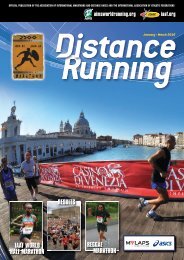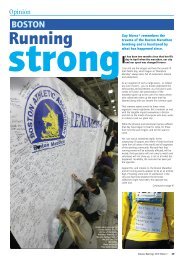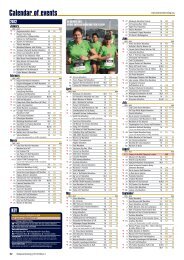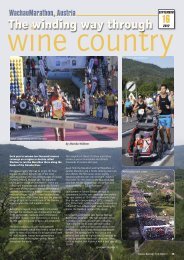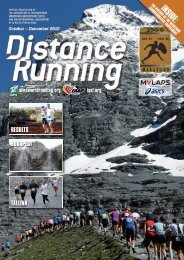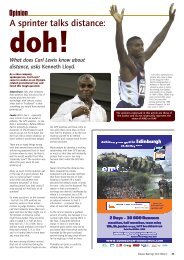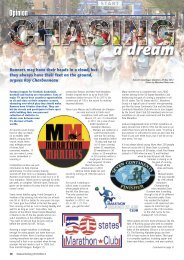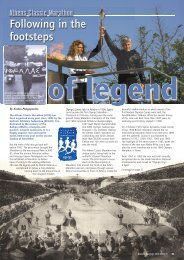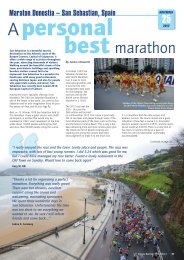A marathon hotspot - Distance Running magazine
A marathon hotspot - Distance Running magazine
A marathon hotspot - Distance Running magazine
- No tags were found...
You also want an ePaper? Increase the reach of your titles
YUMPU automatically turns print PDFs into web optimized ePapers that Google loves.
RUNNING INTO HISTORYReykjavík MarathonSigurdur PeturSimundsson, who wasrace director of theReykjavík Marathon from1992–1994, reaches thefinish line in the 1985eventPhoto: Kristján A. EinarssonBy Eygló SvalaArnarsdóttirThe Reykjavík Marathon celebrates its 30th anniversaryFrom humble beginnings 30 years ago, the Reykjavík Marathon hasgrown to become a major harvest festival for runners in Iceland and a<strong>hotspot</strong> for athletes from abroad. It started out as a bit of a tourismstunt. “At the travel agency Úrval, where I was working at the time,we were looking for ways to attract foreign tourists to the country,”reveals Knútur Óskarsson, one of the founders of the ReykjavíkMarathon. “Originally I tried to establish a Nordic ski <strong>marathon</strong>called Lava Loppet in 1981–82 but those plans went up in the air.”One spring day in 1983 Óskarsson found himself inGothenburg, Sweden. “The streets were closed andpeople were running. I wasn’t aware that theGothenburg Half Marathon was taking place withseveral thousand people participating, among themfamous athletes like Grete Waitz and IngemarJohansson, a boxer who was running for charity.”The race gave Óskarsson the idea to establishsomething similar in Reykjavík. “I pitched it to myboss Steinn Lárusson and he said ‘let’s do it!’ Wecontacted the Icelandic Athletic Federation,Icelandair and Reykjavík City’s Sports andRecreation Council (ÍTR) for collaboration.” A fewdays passed and then the race was on. The nextstep was executing the plan. “In February 1984 Iwas at a travel fair in Berlin and contacted theorganizers of the Berlin Marathon, which had beenrunning for ten years and had built a reputationabroad. Race director Horst Milde agreed to meetme. He told me what needed to be done, which Ilater repeated to my co-workers. Milde stressed theimportance of good collaboration with a radiostation and a newspaper,” recollects Óskarsson.Milde’s advice was taken on board by theorganizers of the Reykjavík Marathon and this year,at its 30th anniversary, he will attend the race as aguest of honour.On 24 August 1984, the first Reykjavík Marathonkicked off with 281 runners. “A road race was anabsolute novelty in Iceland; only two other suchraces existed in the country at that time. Wedecided straight away that we would have threedistances, a full and half <strong>marathon</strong> and a fun run,to have people get used to the idea and to attractthe masses,” explains Óskarsson. Amongparticipants were around 90 foreigners. “ThomGilligan of Marathon Tours in Boston arrived with agroup of runners himself; he has sold trips to therace from the start.” The following year, more than500 people – 100 from abroad – registered for therace. Since then, numbers have been steadilygrowing with registrations jumping from 4,000 to10,000 between 2005 and 2006. In 2012, therewere close to 14,000 registrations including 1,600foreign participants. Around 1,000 runners tookpart in the <strong>marathon</strong> and 2,000 in the half<strong>marathon</strong>, making both races less crowded than isgenerally the case in larger events.“We are proud of the increase of female runners –the ratio between men and women is now almostequal. In 1984, 23% of participants were womenbut in 2012, they accounted for 53% ofparticipants,” says Reykjavík Marathon executiveContinued on page 49A group of runners celebrate after the 1992 ReykjavíkMarathon. Photo: Jóhann A. Kristjánsson<strong>Distance</strong> <strong>Running</strong> | 2013 Edition 3 47
RUNNING INTO HISTORYReykjavík MarathonContinued from page 47director Frímann Ari Ferdinandsson. Today, theReykjavík Marathon Festival includes six distances.In addition to the <strong>marathon</strong> and half <strong>marathon</strong>there is a relay race, 10km run, 3km fun run and achildren’s run – it’s not just for competitive runnersbut is also a family event. “There are many thingsincluded in the registration fee – which is amongthe lowest in Europe – such as a t-shirt, pasta partyand admission to the city’s geothermal pools,”Ferdinandsson points out.“It’s the biggest running festival in Iceland. I find itvery special – I’ve participated from the start. I’vewatched it grow and it’s always a lot of fun,” saysMartha Ernstdóttir, the only Icelandic femaleathlete to have run an Olympic Marathon. Shecompeted for Iceland at Sydney in 2000. TheReykjavík Marathon, which is held on the thirdweekend of August, is always a fixed event on hercalendar. “There are now more people around thecourse and the atmosphere is starting to resemblewhat I’ve experienced at <strong>marathon</strong>s abroad. Butprimarily it’s the masses of runners that make therace different from what it was originally. Theincrease in participants has been incredible andmany foreign runners have joined in,” Ernstdóttirsays of the race’s development.Óskarsson explains that one of the reasons the raceproved a success from the start was that already in1986 the Reykjavík Marathon joined AIMS andthereby had to fulfil all directives and standardsnecessary to host an international <strong>marathon</strong>. “Wehave been conservative and only carried outchanges after careful consideration,” says Knútur.These include acquiring Íslandsbanki bank as a titlesponsor in 2005. This gave a boost to themarketing and in addition to introducing the LazyTown children’s run Reykjavík Marathon started tocollaborate with charities, enabling participants torun for a good cause. A boom in registrationsfollowed over the next few years. Since 2003 theReykjavík Marathon has been managed by theReykjavík Sports Union. The company alsoorganizes the Laugavegur Ultra Marathon,achallenging 55km race that takes place in acolourful geothermal area in the southernhighlands of Iceland, and the Suzuki Midnight SunRun, a growing event that offers a half <strong>marathon</strong>,10km and 5km races.Internationally recognized runners who haveparticipated in the Reykjavík Marathon includeStefano Baldini, Frank Shorter, Hugh Jones, theaforementioned Grete Waitz, Waldemar Cierpinskiand founder of the New York Marathon FredLebow. “Foreign runners have been very positivetowards the Reykjavík Marathon. Some return yearafter year, especially Germans, Canadians andAmericans,” says Ágúst Þorsteinsson, who served asPhoto: Andri ThorstensenRunners in 1984. Photo: Kristján A. Einarssona Reykjavík Marathon race director for 10 years.“They praise the clean air and water. And at thistime of year the temperature is usually around 10-14°C, which is ideal for running a <strong>marathon</strong>,” headds of the Icelandic climate in late August.“I’ll run the <strong>marathon</strong> for the 20th time this year –I never run a half <strong>marathon</strong> when a full <strong>marathon</strong>is an option,” says Gísli Ragnarsson, who has alsoparticipated in <strong>marathon</strong>s in Boston, London andaround Iceland. “Reykjavík is my favourite. There’s avibrant atmosphere and the race is well organized.Now there are more people cheering the runnerson. It’s great to see how the interest in running hasspread in Iceland, at first there were just a feweccentrics. The atmosphere is especially lively withCulture Night taking place the same day,”Ragnarsson adds of an event that has been madeto coincide with the Reykjavík Marathon, theanniversary of Reykjavík. It’s a cultural and familyfestival, which ends with a fireworks show in theevening.The course of the Reykjavík Marathon has remainedmore or less the same since 2000. Until then thefull <strong>marathon</strong> was two laps of the half <strong>marathon</strong>route. But the race has always begun and ended onLækjargata in the heart of Reykjavík with a view ofthe City Hall and Reykjavík Pond, home to ducksand swans. The first part of the course runs througha residential area, which is followed by a sectionalong the sea front with views of the North AtlanticOcean, the Reykjavík landmark Mount Esja, otherscenic mountains and, in clear weather, theSnæfellsjökull Glacier can be seen in the distance.Runners then enter the Laugardalur Park andprogress through the green and forestedElliðaárdalur Valley along a salmon fishing riverwith small waterfalls. Then through theFossvogsdalur Valley, which separates Reykjavíkfrom its neighbouring town Kópavogur. The valleyleads to the Fossvogur Cove, where runners passthe thermal beach Nauthólsvík. They continuealong the coast, all the way to Grótta onSeltjarnarnes, with a view of a lighthouse andseabirds diving into the ocean. Back in the city,runners pass famous buildings such as Höfði, thesite of the 1986 Reagan-Gorbachev summit, animportant step towards ending the Cold War, andthe Harpa concert and conference centre, the latestaddition to Reykjavík’s cityscape.“It’s friendlier, smaller and more rustic than<strong>marathon</strong>s I’ve participated in abroad. It’s morecomfortable, peaceful and not as stressful,”comments one of Iceland’s foremost athletes,<strong>marathon</strong> runner Kári Steinn Karlsson, the firstIcelandic male athlete to compete in a <strong>marathon</strong> atthe Olympics; he placed 42nd at London 2012. Heparticipated in the Reykjavík Marathon 13 timesand holds the best time in the 10km. “Foreignrunners don’t necessarily register to achieve theirbest time. They come here for the views of Esja, toexperience nature and tackle whatever the weathergods have in store for them. It’s part of theatmosphere not to know what to expect.” ■<strong>Distance</strong> <strong>Running</strong> | 2013 Edition 3 49



